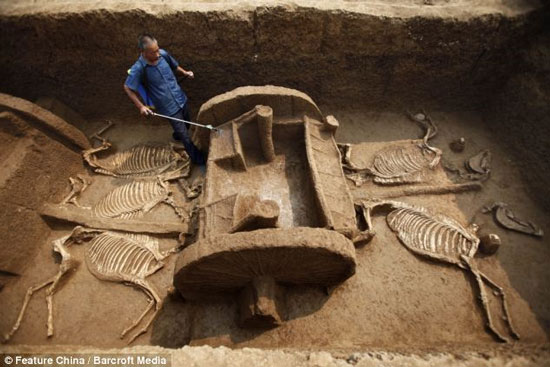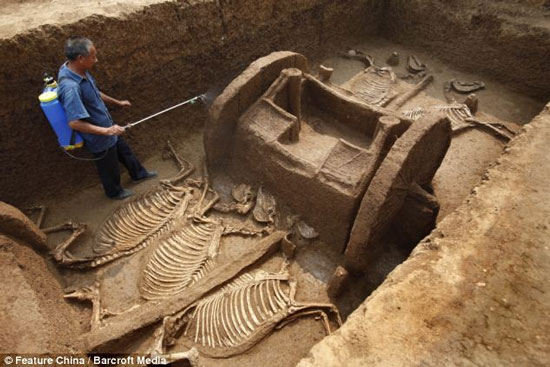Archaeologists have just excavated a tomb dating back about 3,000 years in Luoyang, Henan province, China.
This tomb was initially believed to belong to the Zhou dynasty (a dynasty that existed during the period 1122 – 221 BC).
They found in it the remains of 5 wooden chariots and 12 horses buried around 770 BC.
 An employee is spraying water to maintain the humidity of a 3,000-year-old ancient chariot that was recently excavated in Luoyang, China. (Photo: Dailymail)
An employee is spraying water to maintain the humidity of a 3,000-year-old ancient chariot that was recently excavated in Luoyang, China. (Photo: Dailymail)
This very well-preserved tomb shows evidence of bronze as well as early ceramics of the Western Zhou dynasty.
Although it is much smaller than the famous terracotta army found in 1974 near Xi’an city, Shaanxi province, northwest China, the tomb has not had any disturbance since then. buried and not subject to the ravages of grave robbers.
 The tomb’s contents included weapons, bronzes, ceramics, jade pieces and more. (Photo: Dailymail)
The tomb’s contents included weapons, bronzes, ceramics, jade pieces and more. (Photo: Dailymail)
Archaeologists believe that the owner of the tomb was a major mandarin in the court. Remains of weapons, bronze, pottery, many pieces of jade and remaining writing are proof of that.
In addition, the excavation process also brought many interesting discoveries to historians about funeral customs and rituals in the early Western Zhou period. In particular, the most valuable discovery to date is the complete sets of chariots and horses of different shapes and sizes.
 This tomb also brought many interesting discoveries to historians about the customs and funeral rituals of the Western Zhou period. (Photo: Dailymail)
This tomb also brought many interesting discoveries to historians about the customs and funeral rituals of the Western Zhou period. (Photo: Dailymail)
Archaeologists believe that the mark on the horse’s side shows that people killed them before burying them, not that they were buried alive.
At that time, large-scale irrigation projects were established throughout China and the national writing system continued to develop. That was also the time of famous Chinese philosophers such as Confucius, Mencius, and Chuang Tzu.





